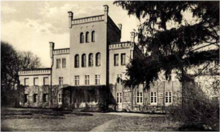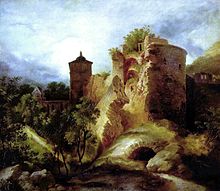Joseph Freiherr von Eichendorff | |
|---|---|
 | |
| Born | Joseph Karl Benedikt Freiherr (Baron) von Eichendorff 10 March 1788 Schloss Lubowitz (Polish: Pałac Eichendorffów) near Ratibor, Prussian Silesia, Kingdom of Prussia |
| Died | 26 November 1857 (aged 69) Neisse (Polish: Nysa), Prussian Silesia, Kingdom of Prussia |
| Occupation | Novelist, poet, essayist |
| Education | Heidelberg University |
| Period | 19th century |
| Genre | Novellas, poetry |
| Literary movement | Romanticism |
| Notable works | Memoirs of a Good-for-Nothing, The Marble Statue |
| Signature | |






Joseph Freiherr von Eichendorff (10 March 1788 – 26 November 1857) was a German poet, novelist, playwright, literary critic, translator, and anthologist.[1] Eichendorff was one of the major writers and critics of Romanticism.[2] Ever since their publication and up to the present day, some of his works have been very popular in German-speaking Europe.[3]
Eichendorff first became famous for his 1826 novella Aus dem Leben eines Taugenichts (freely translated: Memoirs of a Good-for-Nothing)[4] and his poems.[5] The Memoirs of a Good-for-Nothing is a typical Romantic novella whose main themes are wanderlust and love. The protagonist, the son of a miller, rejects his father's trade and becomes a gardener at a Viennese palace where he subsequently falls in love with the local duke's daughter. As, with his lowly status, she is unattainable for him, he escapes to Italy – only to return and learn that she is the duke's adopted daughter, and thus within his social reach.[1] With its combination of dream world and realism, Memoirs of a Good-for-Nothing is considered to be a high point of Romantic fiction. One critic stated that Eichendorff's Good-for-Nothing is the "personification of love of nature and an obsession with hiking."[6] Thomas Mann called Eichendorff's Good-for-Nothing a combination of "the purity of the folk song and the fairy tale."[7]
Many of Eichendorff's poems were first published as integral parts of his novellas and stories, where they are often performed in song by one of the protagonists.[8] The novella Good-for-Nothing alone contains 54 poems.[9]
- ^ a b "Joseph, baron von Eichendorff – German writer".
- ^ Cf. J. A. Cuddon: The Penguin Dictionary of Literary Terms and Literary Theory, revised by C. E. Preston. London 1999, p. 770.
- ^ Cf. Peter Horst Neumann: Eichendorff im technischen Zeitalter. Zu seinem 200. Geburtstag. In: Die Zeit/Zeitmagazin 11. März 1988 http://www.zeit.de/1988/11/eichendorff-im-technischen-zeitalter
- ^ Joseph Freiherr von Eichendorff: Memoirs of a Good-for-Nothing. Ungar, New York 1955. ISBN 0804461341
- ^ Cf. Jürgen Thym: 100 Years Of Eichendorff Songs. Recent Researches in the Music of the Nineteenth and Early Twentieth Centuries, vol. V; A-R Editions, Inc. Madison 1983, p. viii. ISBN 0-89579-173-0
- ^ Cf. Ernst Alker: Die deutsche Literatur im 19. Jahrhundert (1832–1914), 2nd ed., Kröners Taschenbuch vol. 339, Stuttgart 1962, p. 27.
- ^ Hanjo Kesting: Eichendorff und seine Gesellen. Die Wiederkehr der Romantik. http://www.frankfurter-hefte.de/upload/Archiv/2008/Heft_01-02/PDF/080102_86_89.pdf
- ^ Cf. Katja Löhr: Sehnsucht als poetologisches Prinzip bei Joseph von Eichendorff. Epistemata, Würzburger Wissenschaftliche Schriften, Reihe Literaturwissenschaft vol.248, Würzburg 2003, p.12-13. ISBN 3-8260-2536-9
- ^ Cf. Wolfdietrich Rasch (Ed.): Joseph von Eichendorff. Sämtliche Gedichte. Deutscher Taschenbuch Verlag München, 1975, p.502/503. ISBN 3-446-11427-0